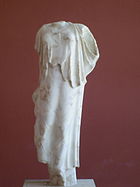Nike (Paros)
The Nike of Paros is an early classical representation of a Nike from the 5th century BC. BC (around 480). The white marble figure was found on the island of Paros before 1885 .
description
The female, originally winged figure is dressed in an open, ungelted peplos and shown floating. Thanks to the wings and the motif of movement, it can be clearly identified as Nike.
The head, the left arm, the right forearm, most of the wings and the feet are missing. Nevertheless, it can be seen that the left leg is slightly forward, while the right leg appears to be set back. This stationary motif in connection with the inclined overall axis of the figure will also be the motif of movement in later Nikes, such as the Nike of Paionios . In the early classical period it replaced the archaic knee run as a schematic form of representation. The sloping body axis, which is mainly created by the straight upper body and the lower body, which is strongly inclined to the left, causes the entire figure to tilt slightly, negating the left leg as a supporting leg. In addition, the left arm must be reconstructed stretched upwards, which takes the figure from its firm footing. Above all, it is the disregard of the rules of gravity that allows the Nike of Paros to float. Accordingly, in the round sculpture there is a change from the side to the front moving figures, which requires a change in the stationary motif.
Deployment context
The function of this Nike cannot be clearly determined. It either served as an acroter or was part of a victory monument. Although from the years 470/460 BC BC no Parian victory has come down to us, it was assumed that it belonged to a victory memorial due to the sculptural elaboration.
literature
- Alexandra Gulaki: Classical and Classicist Nikedabbilder. Dissertation Bonn 1981, p. 36ff.
- Cornelia Isler-Kerényi : Nike. The type of the running wing woman in archaic times. 1969, p. 95ff.
- Y. Kourayos: Paros. Antiparos. 2004, p. 88.
- Cornelia Thöne: Iconographic studies on Nike in the 5th century BC Investigations into the mode of action and nature. Heidelberg 1999, ISBN 3-9804648-2-2 .
- Ph. Zapheiropoulou: Paros. 1998, p. 50.
Individual evidence
- ↑ Alexandra Gulaki: Classic and Classicist Nikedabbilder. Dissertation Bonn 1981, p. 39.

